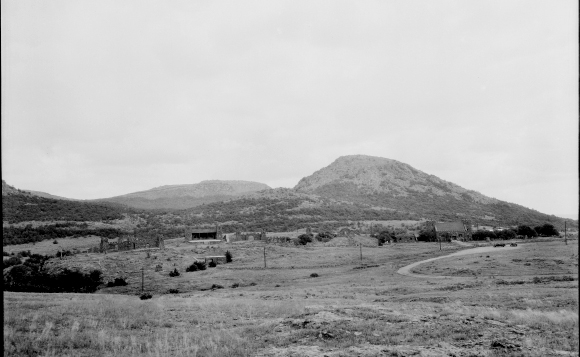The Encyclopedia of Oklahoma History and Culture
HOLY CITY OF THE WICHITAS PAGEANT.
On April 4, 1926, Rev. Anthony Mark Wallock (1890–1948), an Austrian immigrant raised in Chicago, initiated an Easter service and dramatic production with cast of five in the Wichita Mountains of Oklahoma. The play quickly grew into a large, traditional passion play, attracting thousands of spectators each year. Wallock had attended Chicago University and Garrett Biblical Institute, Evansville, Indiana, before accepting leadership of Lawton's Congregational Church in 1924. The 1926 Easter service, held near Medicine Park in the Wichita Mountains, drew two hundred visitors and grew to five hundred the next year. In 1930 approximately six thousand people witnessed the pageant. Oklahoma City's WKY radio broadcast the production live in 1936, and it was carried nationwide on two hundred stations. By the late 1930s the event annually drew more than 100,000 observers. American theaters showed newsreel footage, and in 1937 the U.S. government produced a full-length film of the pageant. In 1949 Hallmark Productions released a color movie, titled The Lawton Story, featuring the Easter pageant. Interestingly, the studio disliked the actors' Oklahoma accents and redubbed the voices. The film premiered in Lawton.
In 1934–35 the Works Progress Administration (WPA) built the present Holy City of the Wichitas five miles west of its original location. The installation was situated twenty-two miles northwest of Lawton. A $94,000 grant supported construction. A dedication ceremony in 1935 commemorated the completion of numerous full-sized buildings and structures, including the temple court, Pilate's judgment hall, Calvary's Mount, the Garden of Gethsemane, watch towers, rock shrines, and perimeter walls. By the next year WPA workers had built the Lord's Supper building, Herod's Court, a chapel, and other amenities. Locally quarried granite was used for the buildings and structures. The chapel replicated Christ Church in Alexandria, Virginia, which George Washington had attended. Murals by artist Irene Malcolm adorn the chapel's ceiling and walls.
The script generally depicts Jesus' life from birth through crucifixion and resurrection. In its first years, the several-hours-long drama began in the early morning, between two and three o'clock, and culminated at sunrise with the resurrection. At sunrise in 1935 skywriter Art Goebel inscribed "Christ Arose," above the pageant grounds, and in subsequent years aviators were hired to write or to drop flowers at the end of the ceremony. Attendance peaked in the 1940s and slowly declined to as few as three thousand in the 1980s. In 1985, trying to bolster the crowd, the pageant changed its schedule to begin at midnight and end in the dark at four in the morning. In 1986 the start time changed to nine o'clock in the evening, although many traditionalists desired the sunrise ending. In 1997 three thousand people experienced one of the nation's longest-running Easter pageants. The event has never charged admission. The 150-acre site is leased from the federal government by the Wichita Mountains Easter Pageant Association, a private organization.
Situated in the Wichita Mountains National Wildlife Refuge, the Holy City of the Wichitas admits tourists during daylight hours. The chapel has hosted a large number of weddings since its construction. Their memories, whether of a wedding or of the pageant, bring many visitors on recurring pilgrimages to the site. In 1975 the Holy City dedicated an eleven-foot-tall, white marble statue titled Christ of the Wichitas, in memory of Reverend Wallock. In 1981 the American Civil Liberties Union (ACLU) filed suit, demanding removal of religious items from federal land. A federal judge dismissed the case. In September 1995 a memorial to the victims of the Oklahoma City Bombing was dedicated at the site.
Easter pageants have also been held in many other churches and communities in Oklahoma. These have included presentations in the 1930s in Platt National Park near Sulphur and in Lincoln Park in Oklahoma City. Two other traditional pageants have occurred: in Tulsa, continuously from 1936 through 2001, and at Kenton, from 1952 into the twenty-first century.
Learn More
Florence Guild Bruce, He is Risen: A History of the Wichita Mountain Easter Pageant (Oklahoma City, Okla.: Harlow Publishing Corporation, 1940).
Jacqulein Vaughn Lowry, The Holy City of the Wichita Mountains, Oklahoma, 1926–1999: A Living History (N.p.: Jacqulein Lowry, 1999).
"Wichita Mountains Easter Pageant," Outdoor Oklahoma 1(March 1940).
Related Resources
Holy City of the Wichitas Historic District, National Register of Historic PlacesCitation
The following (as per The Chicago Manual of Style, 17th edition) is the preferred citation for articles:
Larry O'Dell, “Holy City of the Wichitas Pageant,” The Encyclopedia of Oklahoma History and Culture, https://www.okhistory.org/publications/enc/entry?entry=HO018.
Published January 15, 2010
© Oklahoma Historical Society


